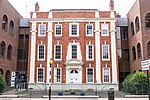Coventry railway station

Coventry railway station is the main railway station serving the city of Coventry, West Midlands, England. The station is on the Birmingham loop of the West Coast Main Line (WCML); it is also located at the centre of a junction where the lines to Nuneaton and to Leamington converge. It is situated on the southern edge of the city-centre, just outside the inner ring road, about 250 yards to the south of junction 6. Coventry station has regular services between London Euston and Birmingham New Street on the WCML. Other services are extended to/from Wolverhampton, Shrewsbury, Preston, Glasgow and Edinburgh Waverley. There are also long distance CrossCountry services to Manchester to the north and Oxford and Bournemouth to the south. Local services also operate between Coventry-Nuneaton, Northampton and Leamington Spa. The station has the PlusBus scheme where train and bus tickets can be bought together at a saving.
Excerpt from the Wikipedia article Coventry railway station (License: CC BY-SA 3.0, Authors, Images).Coventry railway station
Warwick Road, Coventry Spon End
Geographical coordinates (GPS) Address Nearby Places Show on map
Geographical coordinates (GPS)
| Latitude | Longitude |
|---|---|
| N 52.401 ° | E -1.5136 ° |
Address
Coventry Station
Warwick Road
CV3 6AJ Coventry, Spon End
England, United Kingdom
Open on Google Maps









